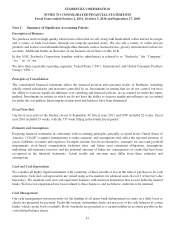Starbucks 2011 Annual Report Download - page 47
Download and view the complete annual report
Please find page 47 of the 2011 Starbucks annual report below. You can navigate through the pages in the report by either clicking on the pages listed below, or by using the keyword search tool below to find specific information within the annual report.estimate of future cash flows include estimated sublease income and lease termination costs. These estimates are
based on historical experience; our analysis of the specific real estate market, including input from independent real
estate firms; and economic conditions that can be difficult to predict. Cash flows are discounted using a rate that
coincides with the remaining lease term.
The liability recorded for location closures contains uncertainties because management is required to make
assumptions and to apply judgment to estimate the duration of future vacancy periods, the amount and timing of
future settlement payments, and the amount and timing of potential sublease rental income.
During the past three fiscal years, we have not made any material changes in the accounting methodology that we
use to calculate our lease abandonment accrual. For the foreseeable future, we do not believe there is a reasonable
likelihood that there will be a material change in the estimates or assumptions that we use to calculate our lease
abandonment accrual. However, if actual results are not consistent with our estimates or assumptions, we may be
exposed to losses or gains that could be material.
A 10% change in our key assumptions for our lease abandonment accrual at October 2, 2011, would not have had a
significant impact on net earnings for fiscal 2011.
Self Insurance Reserves
We use a combination of insurance and self-insurance mechanisms, including a wholly owned captive insurance
entity and participation in a reinsurance treaty, to provide for the potential liabilities for certain risks, including
workers’ compensation, healthcare benefits, general liability, property insurance, and director and officers’ liability
insurance. Key assumptions used in the estimate of our self insurance reserves include the amount of claims incurred
but not reported at the balance sheet date. These liabilities, which are associated with the risks that are retained by
Starbucks are not discounted and are estimated, in part, by considering historical claims experience, demographic,
exposure and severity factors, and other actuarial assumptions. The estimated accruals for these liabilities could be
significantly affected if future occurrences and claims differ from these assumptions and historical trends.
Our self-insured liabilities contain uncertainties because management is required to make assumptions and to apply
judgment to estimate the ultimate cost to settle reported claims and claims incurred but not reported at the balance
sheet date. Periodically, we review our assumptions to determine the adequacy of our self-insured liabilities.
During the past three fiscal years, we have not made any material changes in the accounting methodology that we
use to calculate our self-insurance liabilities. We do not believe there is a reasonable likelihood that there will be a
material change in the estimates or assumptions that we use to calculate our self-insurance liabilities for the
foreseeable future. However, if actual results are not consistent with our estimates or assumptions, we may be
exposed to losses or gains that could be material.
A 10% change in our self-insurance reserves at October 2, 2011 would have affected net earnings by approximately
$13 million in fiscal 2011.
Income Taxes
We recognize deferred tax assets and liabilities based on the differences between the financial statement carrying
amounts and the respective tax bases of our assets and liabilities. Deferred tax assets and liabilities are measured
using current enacted tax rates expected to apply to taxable income in the years in which we expect the temporary
differences to reverse. We routinely evaluate the likelihood of realizing the benefit of our deferred tax assets and
may record a valuation allowance if, based on all available evidence, we determine that some portion of the tax
benefit will not be realized.
In addition, our income tax returns are periodically audited by domestic and foreign tax authorities. These audits
include questions regarding our tax filing positions, including the timing and amount of deductions taken and the
allocation of income among various tax jurisdictions. We evaluate our exposures associated with our various tax
filing positions and record a related liability. We adjust our liability for unrecognized tax benefits and income tax
provision in the period in which an uncertain tax position is effectively settled, the statute of limitations expires for
the relevant taxing authority to examine the tax position, or when more information becomes available.
41
























